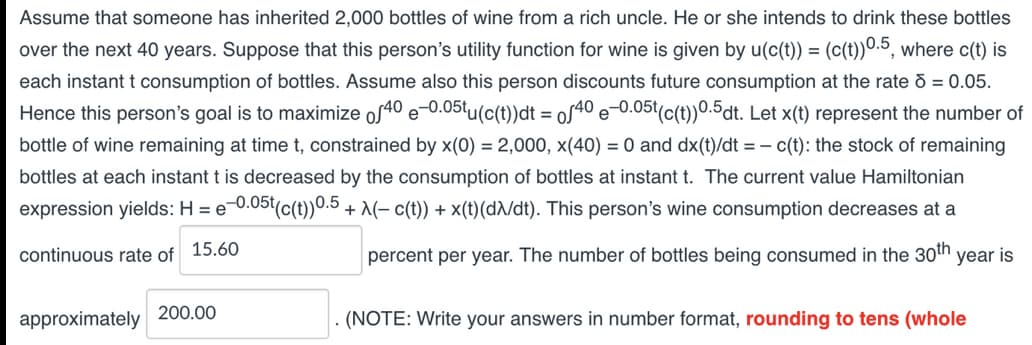Assume that someone has inherited 2,000 bottles of wine from a rich uncle. He or she intends to drink these bottles over the next 40 years. Suppose that this person's utility function for wine is given by u(c(t)) = (c(t))0.5, where c(t) is each instant t consumption of bottles. Assume also this person discounts future consumption at the rate 8 = 0.05. Hence this person's goal is to maximize of40 e-0.05tu(c(t))dt = 0/40 e-0.05t(c(t))0.5dt. Let x(t) represent the number of bottle of wine remaining at time t, constrained by x(0) = 2,000, x(40) = 0 and dx(t)/dt = c(t): the stock of remaining bottles at each instant t is decreased by the consumption of bottles at instant t. The current value Hamiltonian expression yields: H=e-0.05t(c(t))0.5 + XA(- c(t)) + x(t) (dλ/dt). This person's wine consumption decreases at a continuous rate of 15.60 percent per year. The number of bottles being consumed in the 30th year is
Assume that someone has inherited 2,000 bottles of wine from a rich uncle. He or she intends to drink these bottles over the next 40 years. Suppose that this person's utility function for wine is given by u(c(t)) = (c(t))0.5, where c(t) is each instant t consumption of bottles. Assume also this person discounts future consumption at the rate 8 = 0.05. Hence this person's goal is to maximize of40 e-0.05tu(c(t))dt = 0/40 e-0.05t(c(t))0.5dt. Let x(t) represent the number of bottle of wine remaining at time t, constrained by x(0) = 2,000, x(40) = 0 and dx(t)/dt = c(t): the stock of remaining bottles at each instant t is decreased by the consumption of bottles at instant t. The current value Hamiltonian expression yields: H=e-0.05t(c(t))0.5 + XA(- c(t)) + x(t) (dλ/dt). This person's wine consumption decreases at a continuous rate of 15.60 percent per year. The number of bottles being consumed in the 30th year is
Chapter4: Utility Maximization And Choice
Section: Chapter Questions
Problem 4.14P
Related questions
Question
See attachment. This is not a writing assignment. I need to understand the mathematical steps to calculate the continuous rate of wine consumption, and also the number of wine bottles being consumed in the 30th year.

Transcribed Image Text:Assume that someone has inherited 2,000 bottles of wine from a rich uncle. He or she intends to drink these bottles
over the next 40 years. Suppose that this person's utility function for wine is given by u(c(t)) = (c(t))0.5, where c(t) is
each instant t consumption of bottles. Assume also this person discounts future consumption at the rate d = 0.05.
Hence this person's goal is to maximize of40 e-0.05tu(c(t))dt = of40e-0.05t(c(t))0.5dt. Let x(t) represent the number of
bottle of wine remaining at time t, constrained by x(0) = 2,000, x(40) = 0 and dx(t)/dt = c(t): the stock of remaining
bottles at each instant t is decreased by the consumption of bottles at instant t. The current value Hamiltonian
expression yields: H = e-0.05t(c(t))0.5 + λ(− c(t)) + x(t) (dλ/dt). This person's wine consumption decreases at a
continuous rate of 15.60
percent per year. The number of bottles being consumed in the 30th year is
approximately
200.00
(NOTE: Write your answers in number format, rounding to tens (whole
Expert Solution
This question has been solved!
Explore an expertly crafted, step-by-step solution for a thorough understanding of key concepts.
This is a popular solution!
Trending now
This is a popular solution!
Step by step
Solved in 3 steps

Knowledge Booster
Learn more about
Need a deep-dive on the concept behind this application? Look no further. Learn more about this topic, economics and related others by exploring similar questions and additional content below.Recommended textbooks for you

